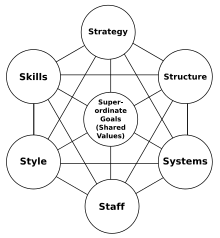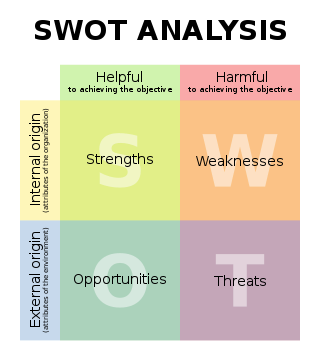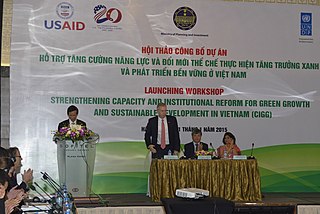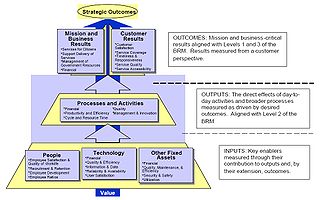Organizational analysis models
Strategic triangle model
This model relies on three key calculations to determine the efficiency and effectiveness of an organization. First, is the value, or mission, that guides the organization. Second, is operational capacity, the knowledge and capability to carry out the mission. Third, is legitimacy and support, or the environment, that authorize the value of the organization, and offer support, (specifically financial support). Using this model, a strategy for an organization is considered good if these three components are in alignment. [2]
SWOT model
A SWOT analysis (alternatively SWOT matrix) is a structured planning method used to evaluate the strengths, weaknesses, opportunities and threats involved in a project or in a business venture. A SWOT analysis can be carried out for a product, place, industry or person. It involves specifying the objective of the business venture or project and identifying the internal and external factors that are favorable and unfavorable to achieve that objective. The degree to which the internal environment of the entity matches with the external environment is expressed by the concept of strategic fit.
- Strengths: characteristics of the business or project that give it an advantage over others.
- Weaknesses: characteristics that place the business or project at a disadvantage relative to others
- Opportunities: elements that the project could exploit to its advantage
- Threats: elements in the environment that could cause trouble for the business or project
First, the decision makers should consider whether the objective is attainable, given the SWOTs. If the objective is not attainable a different objective must be selected and the process repeated. Users of SWOT analysis need to ask and answer questions that generate meaningful information for each category (strengths, weaknesses, opportunities, and threats) to make the analysis useful and find their competitive advantage.
The McKinsey 7S model

The McKinsey 7S Framework emphasizes balancing seven key aspects of an organization, operating unit, or project. [3] Three of the seven elements—strategy, structure, and systems—are considered "hard" elements, easily identified, described, and analyzed. The remaining four elements—shared value, staff, skill, and style—are fluid, difficult to describe, and dependent upon the actors within the organisation at any given time. The 7S organisational analysis framework is based on the premise that all seven elements are interdependent, and must be mutually reinforcing in order to be successful. Changes in a single element can result in misalignment and dysfunction throughout the organisation, disrupting organisational harmony. [4]
Rational model
The rational model stems from the Frederick W. Taylor's (1911) Structural Perspective. Taylor was the father of time-and-motion studies and founded an approach he called "scientific management." [5] It was Taylor's stance that organisations should be as mechanistic and efficient as possible. These Scientific Management principles served a valuable purpose for the Ford Motor Company, where the first American, mass-produced automobiles were being created. [6] The rational model views organizations as a mechanism that is made up of various parts that can be modified in order to create an output in the shortest amount of time and without deviation.
Natural system model
The natural system model is in many ways the opposite of the rational model in that it focuses on the activities that may negatively impact the organization and therefore aims at maintaining an equilibrium in order to meet its goals. [6] The Natural System model views organizations as an organic organism which is holistically interconnected. The parts of the organization are not seen as independent units but rather as a whole that can orchestrate together to prepare for inevitable change.
Sociotechnical model
The sociotechnical model, also known as Sociotechnical Systems (STS), is an approach to complex organizational work design that recognizes the interaction between people and technology in workplaces. The aim of sociotechnical models is to optimize both social and technological sub-systems of work. The term also refers to the interaction between society's complex infrastructures and human behavior. This model identifies the environment as a key factor that interacts with the organization.
Cognitive model
Behavior, cognitive, and other personal factors as well as environmental events, operate as interacting determinants that influence each other bidirectionally. [7] Personal goals of the managers and staff are seen as assisting in the effort toward organizational objective attainment. Decision-making processes are focused on and specialization is deemed as important to the flow of information. [6]
Meta models
Attempts have also been made to put elements of the above models into a kind of meta-model. Based on a theorized blindness of a single perspective, Lee Bolman and Terrence Deal have designed a model that splits analysis into four distinct paradigms. These 'frames' are to be used as a pluralistic model, and therefore allow analysts and leaders to change their thinking by re-framing understanding and points of reference. Bolman and Deal postulate that re-framing is a powerful way to think about situations in multiple ways, which is why taking a meta-model approach enables the development of alternative diagnoses and strategies. [8]
- Structural frame Here organisations are to be understood by role definitions and clear hierarchy. Problems come from overlapping responsibilities and unclear instructions. The assumptions are similar to the rational model shown above and Taylorism.
- Human resource frame According to this frame organisations exist to serve society, they are places for growth and development. Problems come from when people are not motivated or trained sufficiently. This is Similar to the Sociotechnical model, or the work of Daniel Pink.
- Political frame This frame posits that organisations are cutthroat jungles, where only the strongest survive. Problems come from poor power coalitions or overly centralized power.
- Symbolic frame This frame supposes that organisations are deeply symbolic and successful business is about the representation genuine meaning. Problems occur when actors fail to play their parts.
Bolman and Deal lay out these frames in their book Reframing Organizations: Artistry, Choice and Leadership. [5] The authors also provide many examples of how best to apply their four frames analysis.
Organizational network analysis
Organizational network analysis (ONA) is a method for studying communication within a formal organization to make invisible patterns of information flow and collaboration in strategically important groups visible. [9] The method is applied by first mapping the relationships among people, tasks, groups, knowledge and resources of organizational systems. Then, analyzing the collected data with a social network analysis software in order to find organic clusters, opinion leaders, peripheral and bridging actors, indirect relations that are otherwise invisible.




